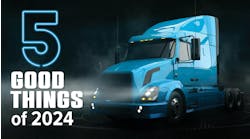To significantly increase sales of hybrid commercial vehicles, more standardized hybrid systems, such as batteries and motors, need to be used and coupled with more government incentives to get sticker prices low enough to attract buyers.
That's because the return-on-investment (ROI) potential is a key determinant for adoption of new technologies, Sandeep Kar, global program manager-commercial vehicle research for Frost & Sullivan, told Fleet Owner. As Kar sees it, hybrid technology standardization coupled with incentives would greatly improve the ROI calculation for these vehicles.
“Batteries and electric motors are the key technologies here,” he said. “For example, we keep hearing about this next wave of lithium-ion batteries that provide more range and longer life. But different lithium-ion formulations are being used by battery makers — and that in turn makes it harder to build economies of scale.”
For example, Alan Mulally, president & CEO of Ford Motor Co., recently noted in an interview with Newsweek that hybrid vehicle battery packs can cost anywhere from $8,000 to $20,000, a cost that significantly impacts the final sticker price of the vehicle.
“Hybrid trucks feature energy storage systems, control and power electronics, and rotating machines, which are expensive technologies creating considerable cost barriers to potential adopters,” pointed out Kar. “Furthermore, storage systems such as batteries must be replaced every four to five years based on the vocational application.”
That's why standardization of key enabling technologies will not only reduce R&D expenses and complexity, but also create a foundation for launching aggressive price reduction strategies that are necessary for stoking market growth, he noted.
That's also why incentives are so critical, Kar stressed, because they will help alleviate the up-front cost pressures and improve the ROI calculation for fleets. That in turn should foster greater demand for hybrid trucks. That demand, he said, should result in economies of scale that will lower the overall price of hybrid trucks and buses.
“Currently, the high up-front cost associated with hybrids is countered with federal grants, incentives, and tax rebates,” explained Kar. “Although such incentives offer relief in the short term, for hybrids to be commercially viable in the long term, the up-front cost difference should be reduced considerably.”
Frost & Sullivan's report titled “Strategic Analysis of North American and European Hybrid Truck, Bus and Van Market” predicts that the hybrid truck, bus and van market is expected to grow from 4,100 units in 2009 to 222,000 units by 2016.
The firm's research, however, indicates that hybrids are the most attractive “alternative fuel” option for fleets as they exert the least pressure on the existing energy and transportation infrastructure and require only minimal modification to the current fueling infrastructure.
“This aspect of hybrid commercial vehicles is acting as one of the strongest market drivers in North America and Europe — attracting governments, commercial vehicle manufacturers, and potential consumers alike towards supporting and accepting hybrid commercial vehicles,” said Kar.


